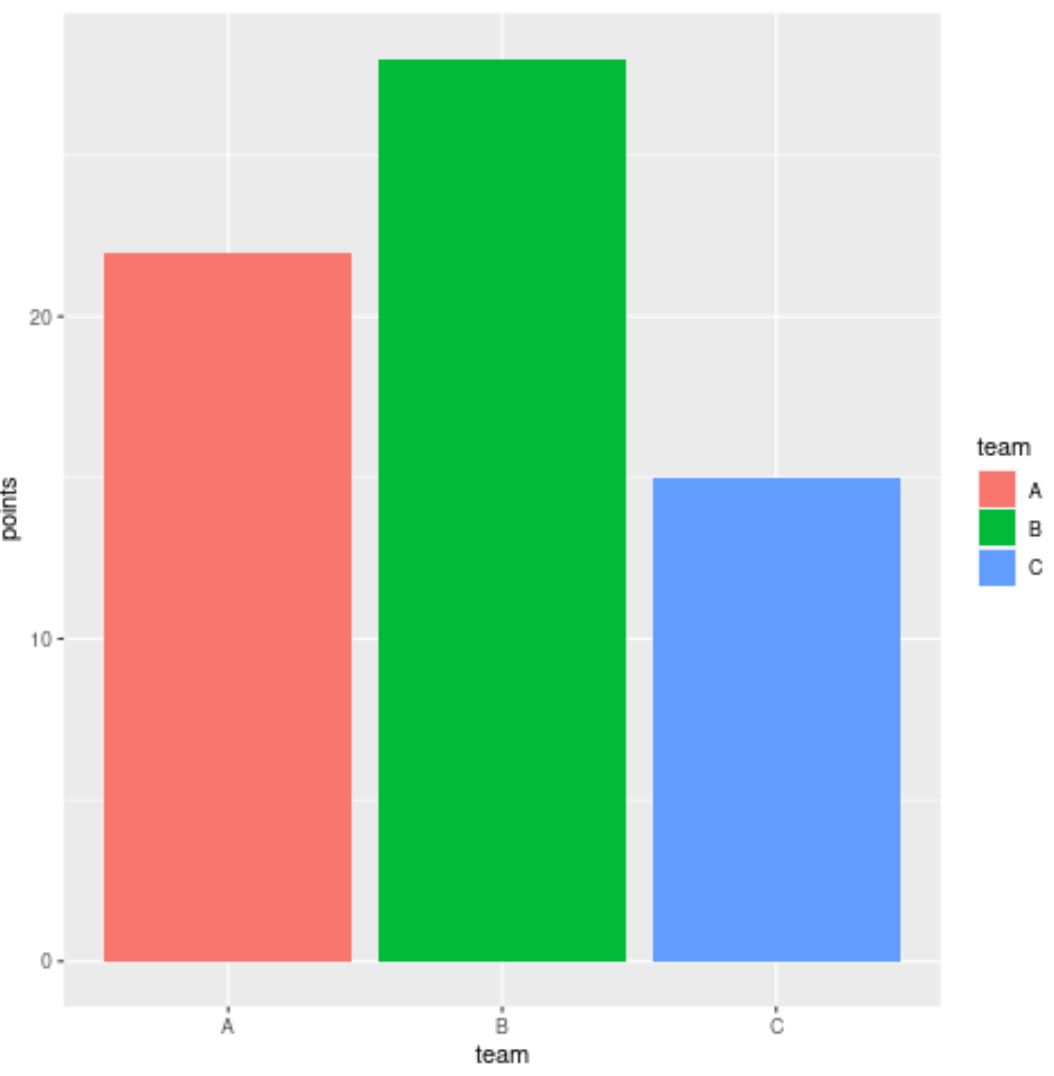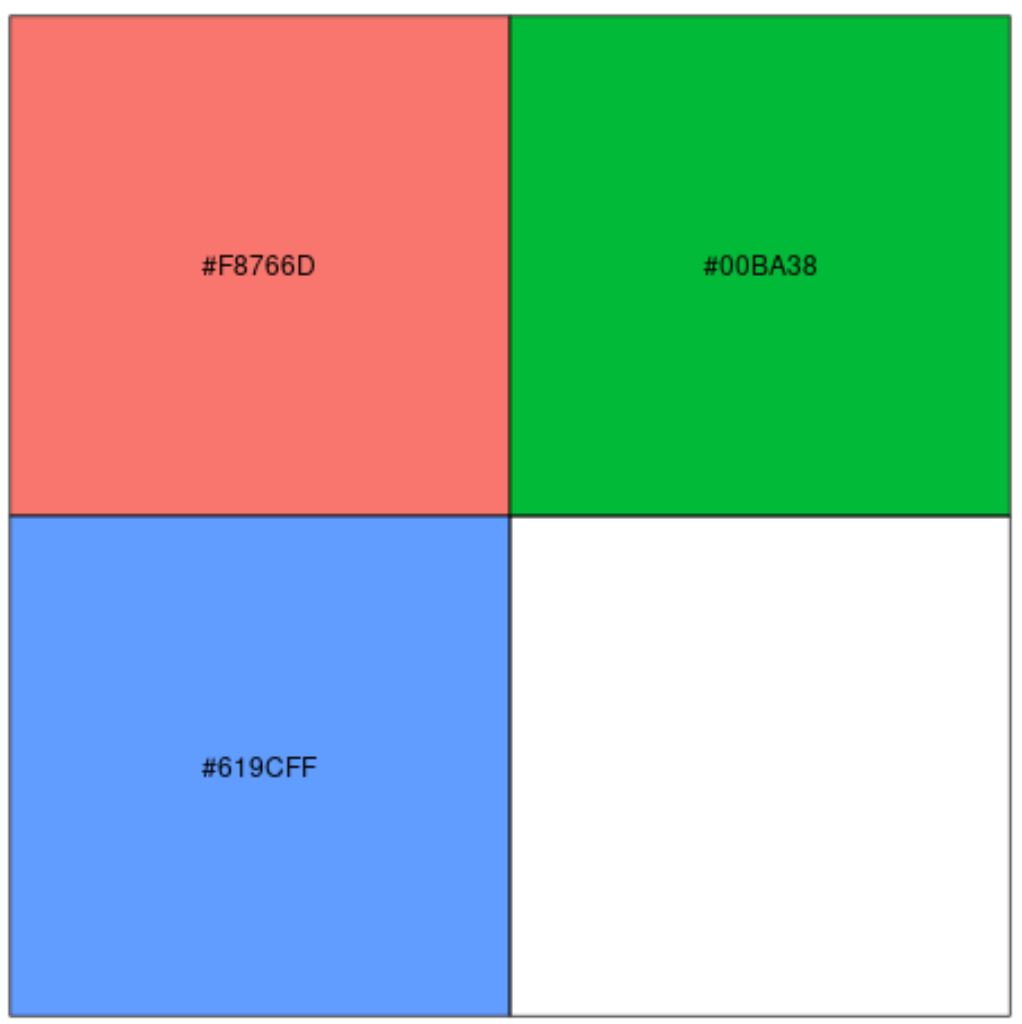คำแนะนำฉบับสมบูรณ์เกี่ยวกับสีเริ่มต้นใน ggplot2
แพ็คเกจ ggplot2 มีรายการสีเริ่มต้นที่ใช้สำหรับองค์ประกอบในพล็อตตามจำนวนองค์ประกอบทั้งหมด
ตัวอย่างเช่น รหัสต่อไปนี้แสดงวิธีการสร้างแผนภูมิแท่งที่มีสามแท่ง:
library (ggplot2)
#create data frame
df <- data. frame (team=c('A', 'B', 'C'),
dots=c(22, 28, 15))
#create bar plot using df
ggplot(df, aes(x=team, y=points, fill=team)) +
geom_bar(stat = " identity ")

ตามค่าเริ่มต้น ggplot2 จะเลือกใช้เฉดสีเฉพาะของสีแดง เขียว และน้ำเงินสำหรับแถบ
เราสามารถใช้ hue_pal() จากแพ็คเกจ scales เพื่อแยกรหัสสีเลขฐานสิบหกจริงที่ใช้ในโครงเรื่อง:
library (scales) #extract hex color codes for a plot with three elements in ggplot2 hex <- hue_pal()( 3 ) #display hex color codes hex [1] "#F8766D" "#00BA38" "#619CFF"
ต่อไปนี้เป็นวิธีการตีความผลลัพธ์:
- รหัสสีฐานสิบหกสำหรับสีแดงในโครงเรื่องคือ #F8766D
- รหัสสีเลขฐานสิบหกสำหรับสีเขียวในโครงเรื่องคือ #00BA38
- รหัสสีเลขฐานสิบหกสำหรับสีน้ำเงินในโครงเรื่องคือ #619CFF
นอกจากนี้เรายังสามารถใช้ show_col() จากแพ็คเกจ สเกล เพื่อซ้อนทับรหัสสีเลขฐานสิบหกลงบนสีจริง:
library (scales) #extract hex color codes for a plot with three elements in ggplot2 hex <- hue_pal()( 3 ) #overlay hex color codes on actual colors show_col(hex)

และเราสามารถใช้โค้ดต่อไปนี้เพื่อสร้างพล็อตที่แสดงสี ggplot2 เริ่มต้นสำหรับพล็อตที่มีองค์ประกอบตั้งแต่หนึ่งถึงแปดองค์ประกอบ:
library (scales) #set margins of plot area by(may = c(0.1, 0, 0.1, 0), bg = " grey85 ") #create plot with ggplot2 default colors from 1 to 8 gc. grid <- layout(matrix(1:8, nrow = 8 )) for (i in 1:8){ gc. ramp <- hue_pal()(i) plot(c(0, 8), c(0,1), type=" n ", bty=" n ", xaxt=" n ", yaxt=" n ", xlab="", ylab="") for (j in 1:i){ rect(j - 1, 0, j - 0.25, 1, col = gc. ramp [j]) } }

และเราสามารถใช้โค้ดต่อไปนี้เพื่อแสดงรหัสสีเลขฐานสิบหกสำหรับแต่ละสีที่แสดงในโครงเรื่อง:
library (scales) #display ggplot2 default hex color codes from 1 to 8 for (i in 1:8){ print (hue_pal()(i)) } [1] "#F8766D" [1] "#F8766D" "#00BFC4" [1] "#F8766D" "#00BA38" "#619CFF" [1] "#F8766D" "#7CAE00" "#00BFC4" "#C77CFF" [1] "#F8766D" "#A3A500" "#00BF7D" "#00B0F6" "#E76BF3" [1] "#F8766D" "#B79F00" "#00BA38" "#00BFC4" "#619CFF" "#F564E3" [1] "#F8766D" "#C49A00" "#53B400" "#00C094" "#00B6EB" "#A58AFF" "#FB61D7" [1] "#F8766D" "#CD9600" "#7CAE00" "#00BE67" "#00BFC4" "#00A9FF" "#C77CFF" "#FF61CC"
แหล่งข้อมูลเพิ่มเติม
บทช่วยสอนต่อไปนี้จะอธิบายวิธีดำเนินการทั่วไปอื่นๆ ใน R:
คู่มือฉบับสมบูรณ์เกี่ยวกับธีม ggplot2 ที่ดีที่สุด
วิธีเปลี่ยนขนาดคำอธิบายแผนภูมิใน ggplot2
วิธีลบคำอธิบายแผนภูมิใน ggplot2